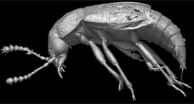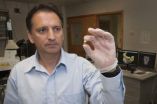(Press-News.org) Washington, D.C.— Molybdenum disulfide is a compound often used in dry lubricants and in petroleum refining. Its semiconducting ability and similarity to the carbon-based graphene makes molybdenum disulfide of interest to scientists as a possible candidate for use in the manufacture of electronics, particularly photoelectronics.
New work from a team including several Carnegie scientists reveals that molybdenum disulfide becomes metallic under intense pressure. It is published in Physical Review Letters.
Molybdenum disulfide crystalizes in a layered structure, with a sheet of molybdenum atoms sandwiched between sheets of sulfur atoms. But it was theorized that changing this structure, without inducing impurities into it, could turn it into a metal. That is, a structural transition might enable electrons to flow smoothly.
The team—including Carnegie's Alexander Goncharov, Haidong Zhang, Sergey Lobanov, and Xiao-Jia Chen—found a way to induce this metallic state by putting molybdenum disulfide under pressure in diamond anvil cells.
They found that molybdenum disulfide underwent structural changes as the pressure increased, and the compound began changing into a new phase. The team was able to determine that these changes were due to lateral shifting of the layers of molybdenum and sulfur.
This process started above 197,000 times normal atmospheric pressure (20 gigapascals), under which the new phase and interlayer stacking arrangement starts to appear and exist in conjunction with the old phase. The complete takeover of the new phase occurs at around 395,000 times normal atmospheric pressure (40 gigapascals), after which the compound became metallic.
They found that all of these changes were reversible when the pressure was decreased again.
"More work is needed to determine whether application of further pressure could yield superconductivity, a rare physical state in which mater is able to maintain a flow of electrons without any resistance at all," Goncharov said.
The rest of the team is comprised of lead author Zhen-Hua Chi of the Chinese Academy of Sciences, co-author Xiao-Miao Zhao of the Center for High Pressure Science and Technology Advanced Research and South China University of Techonology, and co-authors Tomoko Kagayama and Masafumi Sakata of Osaka University.
INFORMATION:
This work was supported by the Natural Science Foundation of China, the Cultivation Fund of the Key Scientific and Technical Innovation Project Ministry of Education of China, SASHIPS, the NSF, EAR, and DARPA
The Carnegie Institution for Science is a private, nonprofit organization headquartered in Washington, D.C., with six research departments throughout the U.S. Since its founding in 1902, the Carnegie Institution has been a pioneering force in basic scientific research. Carnegie scientists are leaders in plant biology, developmental biology, astronomy, materials science, global ecology, and Earth and planetary science.
Pressure probing potential photoelectronic manufacturing compound
2014-07-31
ELSE PRESS RELEASES FROM THIS DATE:
Oldest rove beetle in the Omaliini tribe found in French amber
2014-07-31
An international team of scientists from Spain, France, and the U.S. has discovered and described a rove beetle that is the oldest definitive member of the tribe Omaliini that has ever been found in amber. The discovery and description were made possible through the use of the propagation phase-contrast X-ray synchrotron imaging technique, which allows the detailed study of otherwise invisible specimens in opaque amber. The new species is described in the journal Annals of the Entomological Society of America in an article called "Oldest Omaliini (Coleoptera: Staphylinidae: ...
Free pores for molecule transport
2014-07-31
This news release is available in German.
Metal-organic frameworks (MOFs) can take up gases similar to a sponge that soaks up liquids. Hence, these highly porous materials are suited for storing hydrogen or greenhouse gases. However, loading of many MOFs is inhibited by barriers. Scien-tists of Karlsruhe Institute of Technology (KIT) now report in Nature Communications that the barriers are caused by cor-rosion of the MOF surface. This can be prevented by water-free synthesis and storing strategies.
MOFs are crystalline materials consisting of metallic nodes ...
Scientists shine bright new light on how living things capture energy from the sun
2014-07-31
Since Alexandre Edmond Becquerel first discovered the photovoltaic effect in 1839, humankind has sought to further understand and harness the power of sunlight for its own purposes. In a new research report published in the August 2014 issue of the FASEB Journal, scientists may have uncovered a new method of exploiting the power of sunlight by focusing on a naturally occurring combination of lipids that have been strikingly conserved throughout evolution. This conservation—or persistence over time and across species—suggests that this specific natural combination of lipids ...
Misinformation diffusing online
2014-07-31
The spread of misinformation through online social networks is becoming an increasingly worrying problem. Researchers in India have now modeled how such fictions and diffuse through those networks. They described details of their research and the taxonomy that could help those who run, regulate and use online social networks better understand how to slow or even prevent the spread of misinformation to the wider public.
Krishna Kumar and G. Geethakumari of the Department of Computer Science and Information Systems, at BITS-Pilani, Hyderabad Campus, in Andhra Pradesh, India, ...
Lead in teeth can tell a body's tale, UF study finds
2014-07-31
GAINESVILLE, Fla. – Your teeth can tell stories about you, and not just that you always forget to floss.
A study led by University of Florida geology researcher George D. Kamenov showed that trace amounts of lead in modern and historical human teeth can give clues about where they came from. The paper will be published in the August issue of Science of The Total Environment.
The discovery could help police solve cold cases, Kamenov said. For instance, if an unidentified decomposed body is found, testing the lead in the teeth could immediately help focus the investigation ...
Scientists discover biochemical mechanisms contributing to fibromuscular dysplasia
2014-07-31
An important step has been made to help better identify and treat those with fibromuscular dysplasia (FMD). FMD causes both an abnormal narrowing and enlarging of medium sized arteries in the body, which can restrict blood flow to the kidneys and other organs causing damage. In a new report appearing in August 2014 issue of The FASEB Journal, scientists provide evidence that that FMD may not be limited to the arteries as currently believed. In addition, they show a connection to abnormalities of bones and joints, as well as evidence that inflammation may be driving the ...
New paper describes how DNA avoids damage from UV light
2014-07-31
BOZEMAN, Mont. – In the same week that the U.S. surgeon general issued a 101-page report about the dangers of skin cancer, researchers at Montana State University published a paper breaking new ground on how DNA – the genetic code in every cell – responds when exposed to ultraviolet (UV) light.
The findings advance fundamental understanding of DNA damage by the UV rays found in sunlight. This damage can lead to skin cancer, aging and some degenerative eye diseases.
"Our paper advances foundational knowledge about how DNA responds to UV radiation. In our experiments, ...
Magnetic resonance imaging in patients with transient ischemic attack
2014-07-31
Transient ischemic attack (TIA) is a temporary event, which portends a higher risk of a disabling stroke following the TIA. However, the evaluation and management of TIA vary worldwide and is debated and controversial. Dr. Mohamed Al-Khaled from University of Lübeck in Germany considered With the development of brain imaging, particularly diffusion weighted imaging-magnetic resonance imaging (DWI-MRI), the diagnosis of TIA changed from time-based definition to a tissue-based one. DWI-MRI became a mandatory tool in the TIA workup. The DWI-MRI provides not only the evidence ...
Ligaments disruption: A new perspective in the prognosis of SCI
2014-07-31
Worldwide prevalence of Spinal Cord Injury (SCI) is ranging from 233 to 755 per million inhabitants, whereas reported incidence lies between 10.4 and 83 per million inhabitants per year. Thus, the socioeconomic impact of SCI associated with cervical trauma is high enough to be encountered within one of the most important worries in vast majority of developed countries.
The ability to predict recovery following SCI is of paramount importance to the physician's role in providing the best care and guidance to patients and families during the illness. Diagnosis of cervical ...
Brother of Hibiscus is found alive and well on Maui
2014-07-31
Most people are familiar with Hibiscus flowers- they are an iconic symbol of tropical resorts worldwide where they are commonly planted in the landscape. Some, like Hawaii's State Flower- Hibiscus brackenridgei- are endangered species.
Only a relatively few botanists and Hawaiian conservation workers, however, are aware of an equally beautiful and intriguing related group of plants known as Hibiscadelphus- literally "brother of Hibiscus".
Brother of Hibiscus species are in fact highly endangered. Until recently only one of the seven previously known species remained ...



